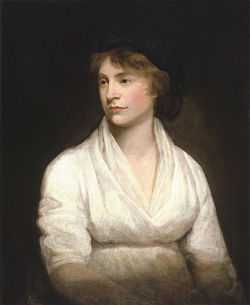Gilbert Imlay
Gilbert Imlay (February 9, 1754 – November 20, 1828) was an American businessman, author, and diplomat. Imlay was known in his day as a shrewd but unscrupulous businessman involved in land speculation in Kentucky. He later served in the U.S. embassy to France and became one of the earliest American writers, producing two books, the influential A Topographical Description of the Western Territory of North America, and a novel, The Emigrants, both of which promoted settlement in the North American interior. However, he is best known today for his brief relationship with British feminist writer Mary Wollstonecraft, which resulted in the birth of a daughter, Fanny Imlay.
Life
Little is known of Imlay's early life. He was born in 1754, probably in Upper Freehold, New Jersey, where the Imlay family first settled in the early 18th century. During the American Revolutionary War he served in the New Jersey Line, enlisting for a time in Forman's Additional Continental Regiment. He rose to the rank of First Lieutenant in the Continental Army; though he would later style himself "Captain", there is no evidence he ever actually attained that rank.[1]
Following his military service, Imlay sought his fortune in Kentucky (then still part of Virginia) and purchased a tract of land in Fayette County in 1783. He arrived there in March 1784, and quickly became involved in land speculation. In 1785 he quietly left America, probably for Europe, leaving a string of unpaid debts in his wake.[2] In 1792 he was in Britain, where he published his influential A Topographical Description of the Western Territory of North America that year.[3] (Subsequent editions would include the adventures of Daniel Boone, written by John Filson, as an appendix.) With Wollstonecraft's assistance, Imlay later tried his hand at fiction, publishing The Emigrants in 1793; both works promoted the American interior and encouraged their settlement by whites.
In 1793, during the French Revolution, he became a diplomatic representative of the United States to France, while at the same time pursuing his own business interests by running the British blockade of French ports. Imlay's excursion into diplomacy led to his meeting Mary Wollstonecraft; to shield herself from the dangers of the French Revolution, she registered at the American Embassy as Imlay's wife, though they never actually married. After the birth of their daughter Fanny, Wollstonecraft followed him to Paris. He returned almost immediately to London, leaving Wollstonecraft and her daughter alone in Paris. She eventually rejoined him in London, where she discovered that Imlay was living with an actress. That effectively ended their relationship, with serious impact on Wollstonecraft's reputation. He showed no interest in his child's welfare, and left her to the care of others after her mother's death three years later.[4][5]
Notes
- ↑ Verhoeven and Gilroy, pp. x–xi.
- ↑ Verhoeven and Gilroy, pp. xi–xiii.
- ↑ Verhoeven and Gilroy, p. xiv.
- ↑ Lucasta Miller, "Rogue Trader", Times Literary Supplement April 25, 2008 p 24.
- ↑ Lewis, Jone Johnson. "Mary Wollstonecraft: A Vindication of the Rights of Woman: overview of the life and work of England's early feminist, Mary Wollstonecraft". Retrieved January 3, 2011.
References
- Faragher, John Mack. Daniel Boone: The Life and Legend of an American Pioneer. New York: Holt, 1992; ISBN 0-8050-1603-1.
- Gilbert Imlay, W. M. Verhoeven, Amanda Gilroy (1998). The Emigrants. Penguin. ISBN 0-14-043672-3
- Verhoeven, Wil. Gilbert Imlay: Citizen of the World. London: Pickering & Chatto, 2008; ISBN 978-1-85196-859-6.
Further reading
- Verhoeven, Wil. "Gilbert Imlay: Citizen of the World". London: Pickering & Chatto, 2008; ISBN 978-1-85196-859-6
|
| ||||||||||
